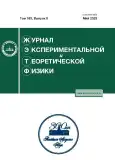Scalaron Decay in Perturbative Quantum Gravity
- Авторлар: Latosh B.N1,2
-
Мекемелер:
- Bogoliubov Laboratory of Theoretical Physics, JINR
- Dubna State University
- Шығарылым: Том 163, № 5 (2023)
- Беттер: 628-640
- Бөлім: Articles
- URL: https://journals.rcsi.science/0044-4510/article/view/145401
- DOI: https://doi.org/10.31857/S0044451023050024
- EDN: https://elibrary.ru/BBVSSE
- ID: 145401
Дәйексөз келтіру
Толық мәтін
Аннотация
A certain quadratic gravity model provides a successfully inflationary scenario. The inflation is driven by the new scalar degree of freedom called scalaron. After the end of inflation the scalaron decays in matter and dark matter degrees of freedom reheating the Universe. We study new channels by which the scalaron can transfer energy to the matter sector. These channels are annihilation and decay via intermediate graviton states. Results are obtained within perturbative quantum gravity. In the heavy scalaron limit only scalar particles are produced by the annihilation channel. Scalaron decays in all types of particles are allowed. In the light scalaron limit decay channel is strongly suppressed. Boson production via the annihilation channel is expected to be dominant at the early stages of reheating, while fermion production will dominate later stages.
Авторлар туралы
B. Latosh
Bogoliubov Laboratory of Theoretical Physics, JINR; Dubna State University
Хат алмасуға жауапты Автор.
Email: latosh@theor.jinr.ru
141980, Dubna, Russia; 141982, Dubna, Russia
Әдебиет тізімі
- A. Accioly, S. Ragusa, H. Mukaim, and E. C. de Rey Neto, Int. J. Theor. Phys. 39, 1599 (2000); doi: 10.1023/A:1003632311419
- A. Hindawi, B. A. Ovrut, and D. Waldram, Phys. Rev. D 53, 5583 (1996); doi: 10.1103/PhysRevD.53.5583 [arXiv:hep-th/9509142 [hep-th]].
- R. H. Dicke, Phys. Rev. 125, 2163 (1962); doi: 10.1103/PhysRev.125.2163.
- K. i. Maeda, Phys. Rev. D 39, 3159 (1989); doi: 10.1103/PhysRevD.39.3159.
- V. Faraoni, E. Gunzig, and P. Nardone, Fund. Cosmic Phys. 20, 121 (1999) [arXiv:gr-qc/9811047 [gr-qc]].
- A. De Felice and S. Tsujikawa, Living Rev. Rel. 13, 3 (2010) doi: 10.12942/lrr-2010-3 [arXiv:1002.4928 [gr-qc]].
- A. A. Starobinsky, Phys. Lett. B 91, 99 (1980); doi: 10.1016/0370-2693(80)90670-X.
- Y. Akrami et al. [Planck], Astron. Astrophys. 641, A10 (2020); doi: 10.1051/0004-6361/201833887 [arXiv:1807.06211 [astro-ph.CO]].
- P. A. R. Ade et al. [BICEP and Keck], Phys. Rev. Lett. 127, no.15, 151301 (2021); doi: 10.1103/PhysRevLett.127.151301 [arXiv:2110.00483 [astro-ph.CO]].
- D. Paoletti, F. Finelli, J. Valiviita, and M. Hazumi, [arXiv:2208.10482 [astro-ph.CO]].
- G. Galloni, N. Bartolo, S. Matarrese, M. Migliaccio, A. Ricciardone, and N. Vittorio, [arXiv:2208.00188 [astro-ph.CO]].
- A. Vilenkin, Phys. Rev. D 32, 2511 (1985); doi: 10.1103/PhysRevD.32.2511.
- A. S. Koshelev, L. Modesto, L. Rachwal, and A. A. Starobinsky, JHEP 11, 067 (2016); doi: 10.1007/JHEP11(2016)067 [arXiv:1604.03127 [hep-th]].
- E. V. Arbuzova, A. D. Dolgov, and L. Reverberi, JCAP 02, 049 (2012); doi: 10.1088/1475-7516/2012/02/049 [arXiv:1112.4995 [gr-qc]].
- E. V. Arbuzova, A. D. Dolgov, and R. S. Singh, JCAP 07, 019 (2018); doi: 10.1088/1475-7516/2018/07/019 [arXiv:1803.01722 [gr-qc]].
- E. Arbuzova, A. Dolgov, and R. Singh, Symmetry 13, 877 (2021); doi: 10.3390/sym13050877.
- B. N. Latosh, Phys. Part. Nucl. 51, 859 (2020); doi: 10.1134/S1063779620050056 [arXiv:2003.02462 [hep-th]].
- C. P. Burgess, Living Rev. Rel. 7, 5 (2004); doi: 10.12942/lrr-2004-5 [arXiv:gr-qc/0311082 [gr-qc]].
- M. Levi, Rept. Prog. Phys. 83, 075901 (2020); doi: 10.1088/1361-6633/ab12bc [arXiv:1807.01699 [hep-th]].
- X. Calmet, Int. J. Mod. Phys. D 22, 1342014 (2013); doi: 10.1142/S0218271813420145 [arXiv:1308.6155 [gr-qc]].
- P. Vanhove, [arXiv:2104.10148 [gr-qc]].
- G. 't Hooft and M. J. G. Veltman, Ann. Inst. H. Poincare Phys. Theor. A 20, 69 (1974).
- M. H. Goro and A. Sagnotti, Phys. Lett. B 160, 81 (1985); doi: 10.1016/0370-2693(85)91470-4.
- D. Prinz, Class. Quant. Grav. 38, 215003 (2021); doi: 10.1088/1361-6382/ac1cc9 [arXiv:2004.09543 [hep-th]].
- B. S. DeWitt, Phys. Rev. 162, 1239 (1967); doi: 10.1103/PhysRev.162.1239.
- S. Sannan, Phys. Rev. D 34, 1749 (1986); doi: 10.1103/PhysRevD.34.1749.
- B. Latosh, Class. Quant. Grav. 39, 165006 (2022); doi: 10.1088/1361-6382/ac7e15 [arXiv:2201.06812 [hep-th]].
- R. Mertig, M. Bohm, and A. Denner, Comput. Phys.Commun. 64, 345 (1991); doi: 10.1016/0010-4655(91)90130-D.
- V. Shtabovenko, R. Mertig, and F. Orellana, Comput. Phys.Commun. 256, 107478 (2020); doi: 10.1016/j.cpc.2020.107478 [arXiv:2001.04407 [hep-ph]].
- H. H. Patel, Comput. Phys.Commun. 197, 276 (2015); doi: 10.1016/j.cpc.2015.08.017 [arXiv:1503.01469 [hep-ph]].
- H. H. Patel, Comput. Phys.Commun. 218, 66 (2017); doi: 10.1016/j.cpc.2017.04.015 [arXiv:1612.00009 [hep-ph]].
- V. Shtabovenko, Comput. Phys.Commun. 218, 48 (2017) doi: 10.1016/j.cpc.2017.04.014; [arXiv:1611.06793 [physics.comp-ph]].
- S. Mandelstam, Phys. Rev. 115, 1741 (1959); doi: 10.1103/PhysRev.115.1741.
- S. Mandelstam, Phys. Rev. 112, 1344 (1958); doi: 10.1103/PhysRev.112.1344.
- S. M. Bilenky, Introduction to Feynman Diagrams and Electroweak Interactions Physics, Moscow, Nauka (1995).
- S. Weinberg, The Quantum theory of elds. Vol. 1: Foundations, Cambridge University Press (2005).
- M. E. Peskin and D. V. Schroeder, An Introduction to quantum eld theory, Addison-Wesley (1995).
- Y. b. Zeldovich, Adv. Astron. Astrophys. 3, 241 (1965); doi: 10.1016/b978-1-4831-9921-4.50011-9.
- B. W. Lee and S. Weinberg, Phys. Rev. Lett. 39, 165 (1977); doi: 10.1103/PhysRevLett.39.165.
- G. Passarino and M. J. G. Veltman, Nucl. Phys. B 160, 151 (1979); doi: 10.1016/0550-3213(79)90234-7.
Қосымша файлдар









